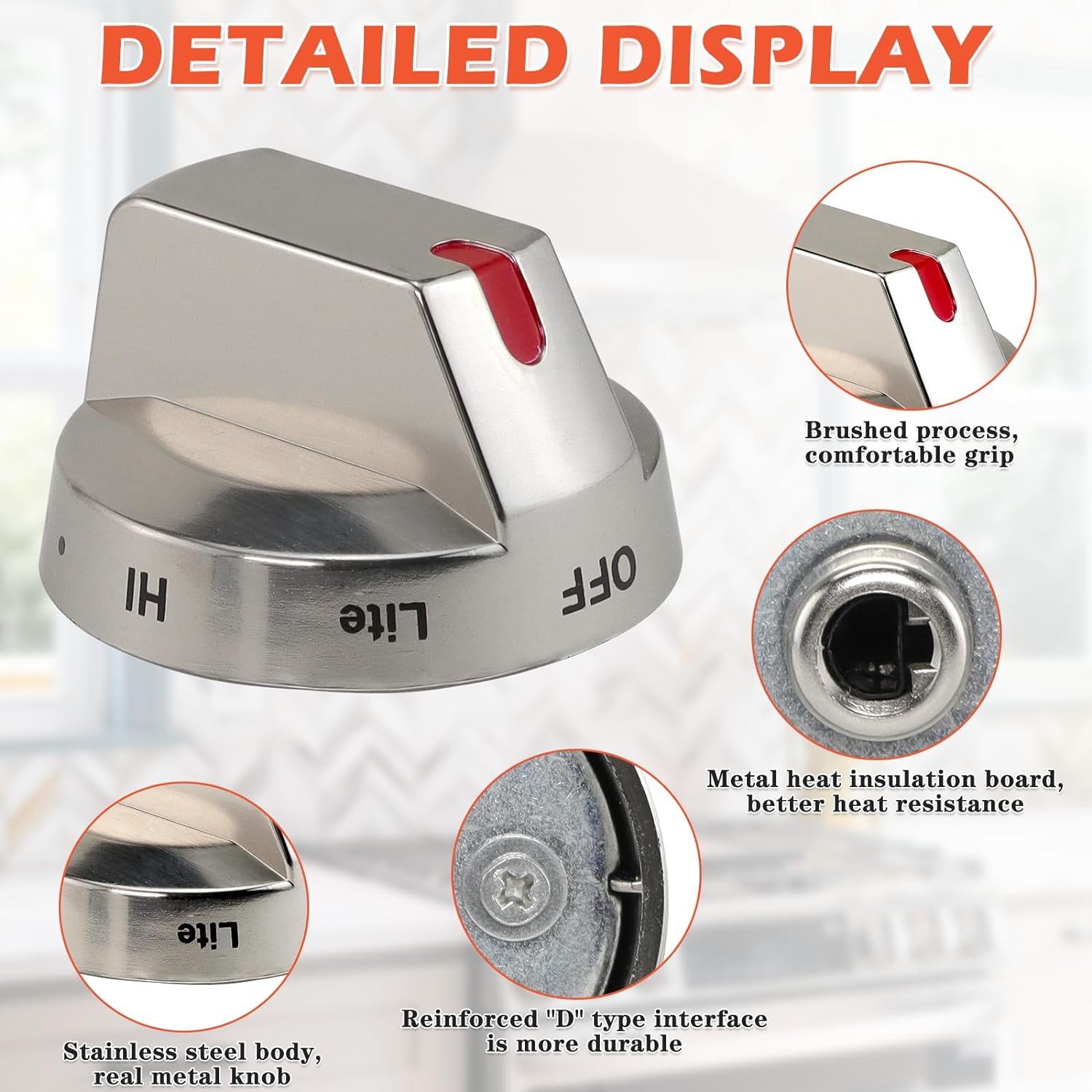A slide-in range and a freestanding range have the same features. Their main difference is; slide-in ranges are built into cabinetry and require less space, while freestanding ranges can be placed anywhere in the kitchen.
When remodeling your kitchen, you need to decide whether or not you want a freestanding range or a slide-in gas range. In this case, the best gas range for home chefs might help you.
Both types have their pros and cons. When your kitchen is small, a slide-in range may be more convenient since it takes up less space than a freestanding one. I will clarify the difference between slide in vs freestanding range so you can identify them easily.
What is a Freestanding Range?
Freestanding ranges do not require a ventilation system to function, making them a good option for small spaces. The ranges are called “freestanding” because they don’t need to be connected to other appliances or plumbing like traditional kitchen ranges. For this reason, they are excellent choices for homes without the space necessary to accommodate traditional appliances.
A freestanding range is a kitchen appliance designed to cook food using an electric or gas burner. Freestanding ranges can be purchased with either 4 or 6 burners and are typically more expensive than ovens with the same number of burners. It is easier for them to swap between dishes when cooking for larger parties. Although freestanding ranges are typically less energy efficient than built-in ovens.
Related Post: Who Makes Thor Appliances
Freestanding Ranges Offer the Following Advantages
- Freestanding ranges come with a blackguard to prevent grease, smoke, and splatters from damaging the wall.
- You have more flexibility with a freestanding installation if you intend to change your kitchen layout in the future.
- Ranges are not required to have a separate backsplash, but slide-in ranges do.
- All free-standing ranges come with finished sides, although they may be painted differently. Black-finished sides are available on some stainless steel freestanding ranges.
- A freestanding range provides more cooking and storage space by separating the cooking area and the oven. Spills and splatters can also be cleaned up in one place.
- Freestanding ranges can be moved to any location in the home, and their small size makes them easy to store when not in use.
- They are also available in a wide range of styles and colors, so you can find the one that will match your kitchen perfectly.
Freestanding Ranges: Pros and Cons
Pros
- Cheaper than slide-in ranges
- Available in a variety of sizes and finishes
- No need to be sandwiched between cabinets
- Multiple package options to choose from
Cons
- Backguard controls can be difficult to reach for kids
- Cleaning between cabinets and stoves can be a hassle
- Adjusting controls can be challenging when reaching over cookware or hot burners
- Models without blackguards may not blend in as well
What is a Slide-In Range?
A slide-in range fits under your kitchen counter or stove. With its sleek, glossy, and seamless surface, a slide-in range looks like your kitchen counter. Slide-in ranges feature hidden burners to make installation easy. Each burner on the top of the range has 10,000 BTUs of power.
Slide-in ranges have become popular in new homes in recent years. With a slide-in range, you can save space as it slides into a cabinet. With energy-efficient appliances, your utility bills will also drop and you’ll have more room for storage!
There is a single hole for installing a dishwasher under a slide-in range. Top-rated slide-in ranges require less space than other designs. There are many benefits to having a slide-in range in the kitchen, and we’ll explain them in this article.
Slide-In Ranges Offer the Following Advantages
- Installing a slide-in stove between cabinets creates a built-in look. A hidden backguard protects the range behind the counter.
- The controls for all the settings are located on the front of the appliance, making it easy to adjust them.
- The countertop and the cooking surface flow smoothly into one another.
- A slide-in range with built-in downdraft ventilation is better than a traditional range hood. In a streamlined design, this range lets you cook, bake, and ventilate simultaneously.
- Several brands offer FIT Systems to ensure that products fit your space. In other words, you can flawlessly install a slide-in range with the FIT System Limited Guarantee into an existing cutout that is 30″ wide, 24″-25″ depth of countertop, 23″-24″ deep cabinet, and 36 inches high.
- If you want to save space in your kitchen, a slide-in range is a great idea. A great home investment, this invention is both handy and practical.
- Compared to freestanding ranges, slide-in ranges can save homeowners up to $2,500 on new appliance costs.
- Modern slide-in models feature top-of-the-line technology for convenience and safety, as well as high efficiency.
Slide-In Ranges: Pros and Cons
Pros
- Premium appearance with built-in design
- No spillage on the sides due to cooktop overlap
- Comprehensive feature set and flexible installation options
Cons
- Front controls can be easily accessed by kids
- More expensive than freestanding ranges
Freestanding vs Slide in Range – What’s the Difference?
1. Installation
As their name suggests, slice-in ranges slide into cabinets. In contrast, freestanding ranges stand alone. But this isn’t all.
Slide-in ranges are designed to be installed into cabinets, so their sides are not finished. You cannot place them at the end of your cabinet line. No pedestal is necessary.
There is no need to sit on the freestanding models because they do not require any support. They have finished sides.
Hence, they are more flexible and versatile since you can place them anywhere within a cabinet or at the end of the cabinet line.
2. Control Location
Freestanding ranges are equipped with burner controls, oven controls, or both. They typically feature a display control on the front.
By placing these units against a wall, they block the backsplash. Adjusting the burners can also be uncomfortable over a hot cooktop or meal.
In contrast, slide-in ranges provide a clear view of the backsplash. They may also be installed against a wall. Cooktop surface knobs and front controls can be used without reaching over hot food or surfaces. Does this sound more convenient?
3. Cleaning
The freestanding range stands on its own. The cooktop surface is usually separated from the adjacent cabinet by a small gap. In this area, liquids and food may fall.
A slide-in range prevents this from happening because the cooktop surface overlaps the cabinetry, so nothing falls between them.
4. Appearance
With their overlapping cooktop surfaces and knob placement, slide-in ranges add a built-in look to modern or new kitchens. Additionally, they allow their surroundings to be opened up.
In contrast, a freestanding range is independent. You need to consider your needs, preferences, and budget when choosing a product. Compare both models before making your choice.
5. Slide in vs freestanding range cost comparison
Slide-in ranges cost about 10% more than freestanding options (back in the day, that was considered one of their selling points; however, now floor models are much cheaper). Currently, slide-in ranges range from $474 (for an affordable, energy-efficient range) to $7,500 (for a high-end stainless steel range).
Here’s a table of key differences between freestanding and slide-in ranges:
| Key Difference | Freestanding Range | Slide-In Range |
|---|---|---|
| Installation | Can be installed anywhere in the kitchen as a stand-alone unit | Needs to be installed between cabinets or countertops for a seamless appearance |
| Controls | Rear-mounted controls | Front-mounted controls |
| Design | Typically has finished sides and a backguard | Designed to fit flush with countertops and cabinets, with no backguard |
| Price (USD) | $500-$1500 | $1000-$4000 |
| Cleaning | May have small gaps between the range and surrounding countertops, making it easier for crumbs and spills to accumulate | Designed to fit snugly between cabinets and countertops, making cleaning spills and crumbs easier |
| Flexibility | Can be easily replaced or moved if you change your kitchen layout | Must be replaced with a similarly-sized range if you change your kitchen layout |
| Appearance | Has a more traditional appearance that may not fit in with modern kitchen designs | Has a sleek, modern appearance that complements modern kitchen designs |
| Size | Available in a variety of sizes, typically ranging from 20-60 inches | Available in a variety of sizes, typically ranging from 20-48 inches |
| Cooking Features | Typically offers standard cooking features, such as bake, broil, and simmer | Offers advanced cooking features, such as convection cooking and multiple burners with varying heat levels |
| Energy Efficiency | May have gaps that allow heat to escape, resulting in higher energy costs | Designed to fit snugly, resulting in better energy efficiency and lower energy costs |
Can a free-standing range be used as a slide-in?
Yes, a free-standing range can be used as a slide-in. As long as it has the same dimensions as a standard range.
The only difference is the width of the front of the stovetop. Make sure that your cabinet can fit around the stovetop’s front and does not have any obstructions on either side.
Can a slide-in range replace a freestanding range?
Slide-in ranges cannot replace freestanding ranges.
In comparison to a slide-in range, a freestanding range has a number of advantages. It can be installed in any kitchen. As a result, you won’t need to modify walls or floors during installation.
The installation of a slide-in range has a certain degree of flexibility, but the sliding door needs to be set up in an area that has enough clearance. Additionally, slide-in units are expensive.
Summary: Slide-In vs Freestanding Range
Slide-in ranges cost more, have a smaller variety of sizes, and cannot be moved to suit your needs. The cost of freestanding ranges is less, and you can find the right size to fit your room easily.
If you want a stove that is mobile, consider a freestanding range. With the Slide-in range, you’ll get an elegant look.
I hope in this slide in vs freestanding range guide we have given some insights and answered some related questions. If you want any information or any clarification do comment below on this article.

Katie Lee has over 20 years of experience in the kitchen. She helps homeowners find the right appliances for their needs to sets up a perfect kitchen system. She also shares helpful tips and tricks for optimizing appliance performance.


